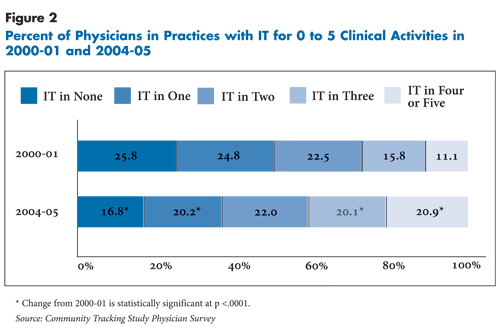
Growing Availability of Clinical Information Technology in Physician Practices
Data Bulletin No. 31
June 2006
Marie C. Reed, Joy M. Grossman
![]() uring the first half of the decade, physician access to
practice-based clinical information technology (IT) grew significantly, according
to findings from HSC’s nationally representative Community Tracking Study Physician
Survey (see Figure 1).
uring the first half of the decade, physician access to
practice-based clinical information technology (IT) grew significantly, according
to findings from HSC’s nationally representative Community Tracking Study Physician
Survey (see Figure 1).
The survey asked physicians about the use of IT in their practice for five clinical activities rather than about the use of specific technologies.1 The use of IT in each of the following activities has been shown to improve patient care:2
- Obtaining information about treatment alternatives or recommended guidelines;
- Exchanging clinical data and images with other physicians;
- Accessing patient notes, medication lists or problem lists;
- Generating preventive treatment reminders for the physician’s use; and
- Writing prescriptions.
Between 2000-01 and 2004-05, the proportion of physicians reporting access to IT for each of the five clinical activities grew by at least 5 percentage points. For example, 64.8 percent of doctors in 2004-05 said they had access to IT to obtain treatment guidelines, up from 52.9 percent in 2000-01. In the case of electronic prescribing, the rate nearly doubled from 11.4 percent of physicians in 2000-01 to 21.9 percent in 2004-05.
Because physicians were asked about IT availability in their practice but not whether they actually use the technology or the frequency or intensity of use, the estimates presented here should be considered an upper bound on the proportion of physicians regularly using clinical IT in their practices.
Physicians also were more likely to be in practices that used IT for multiple clinical activities in 2004-05 than four years earlier (see Figure 2). The proportion of physicians reporting their practice has IT access for four or five of the clinical activities nearly doubled over the period, growing from 11.1 percent to 20.9 percent. And significantly fewer physicians reported being in practices with limited clinical IT, with the percentage of physicians in practices with IT for no more than one clinical activity dropping from 50.6 percent to 37.0 percent.


Many Still Lack Clinical IT
While more physicians have access to clinical IT in their practices, many physician practices have barely begun to take advantage of the capabilities of clinical information technology. In 2004-05, 16.8 percent of physicians did not have access to clinical IT in their practice for any of the five activities examined. And 20.2 percent had IT for only one activity.
Thus, despite substantial growth rates for clinical IT across the five clinical activities—between 23 percent and 97 percent over the four-year period—many physicians still lack access to practice-based clinical information technology. For example, the near doubling of the proportion of physicians in practices with electronic prescribing stemmed from a small base of 11.4 percent in 2000-01. Despite the high rate of growth, nearly 80 percent of physicians lacked IT to write prescriptions in 2004-05. And more than a third of physicians didn’t have IT for the easiest-to-implement activity—accessing guidelines and treatment alternatives.
In general, major barriers to physician adoption of clinical IT include start-up and maintenance costs, as well as the significant effort and costs of changing workflow to effectively use IT.3 Therefore, it is not surprising that most physicians first start with the activity that is lowest cost and least disruptive—accessing guidelines and treatment alternatives. In fact, a large majority (59.2%) of those with IT for just one clinical activity reported their practice used IT to access information about treatment alternatives or recommended guidelines. And, it is likely that most physicians in practices with limited IT use the Internet to obtain information on treatment alternatives, something that requires little additional cost or reworking of office procedures in contrast to more sophisticated clinical decision support tools.
Looking Ahead
This analysis is the first based on nationally representative survey data to corroborate anecdotal reports that physician access to clinical IT increased over the first half of the decade. On an annual basis, the proportion of physicians with IT for the various clinical activities examined increased an average of between 1 and 4 percentage points a year. The fairly slow average year-to-year growth and the significant proportion of physicians that continue to have only limited access to clinical IT suggest that physicians as a group have not yet reached a tipping point in the adoption of IT for most clinical activities. During this same period, however, there has been rapid expansion in the scope of public and private efforts to promote clinical IT adoption in physician practices. These activities may help drive more momentum among physicians to adopt IT in the remainder of the decade.
Notes
Data Source
This Data Bulletin presents findings from the HSC Community Tracking Study Physician Survey, a nationally representative telephone survey of physicians involved in direct patient care in the continental United States conducted in 1996-97, 1998-99, 2000-01 and 2004-2005. The sample of physicians was drawn from the American Medical Association and the American Osteopathic Association master files and included active, nonfederal, office- and hospital-based physicians who spent at least 20 hours a week in direct patient care. Residents and fellows were excluded. Questions on information technology were added to the 2000-01 survey and continued in the 2004-05 survey. The 2000-01 survey contains information on about 12,000 physicians, while the 2004-05 survey includes responses from more than 6,600 physicians. The response rates were 52 percent (2004-05) and 59 percent (2000-01). More detailed information on survey methodology can be found at www.hschange.org.